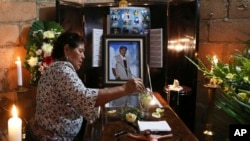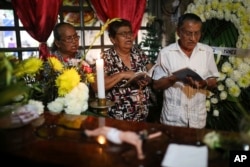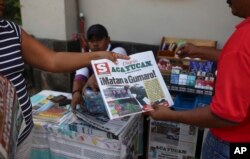International condemnation rolled in Wednesday over the murder of a journalist in Mexico's Veracruz state, the latest in a wave of such killings seen as an assault on free speech in the country.
The United Nations' human rights agency said in a statement through its Mexico office that the slaying of Gumaro Perez "confirms a terrible year for freedom of expression in Mexico.''
The Inter-American Press Society expressed its "consternation over the toll of journalists killed this year in the country, most of them with impunity.''
The 34-year-old Perez was shot to death Tuesday while at a Christmas party at his son's school in Acayucan, in the Gulf state of Veracruz. He was at least the 10th journalist slain in the country this year and the third in Veracruz.
The state prosecutor's office sought to cast doubt on Perez's journalistic credentials, issuing a statement Wednesday saying it had not been able to find any media outlet that he was actively working for and that a website under his authorship went inactive a few months ago.
That was disputed by an official with a regional program for journalist protection who said Perez had been working for the local government but continued to publish on a web portal and his Facebook page.
"For all legal purposes he was a journalist,'' said Jorge Morales of the Veracruz State Commission for Attention and Protection of Journalists. "We could say he was independent.''
Morales added that several people reported Morales' role with the municipal government had been as either a communications worker or an assistant to the mayor, though it was apparently in an informal capacity and he was not on the payroll.
Veracruz prosecutors also said in a statement it was "probable'' that Perez was linked to an organized crime gang and was killed by a rival group. The office cited information pulled from his cellphone and visits made to an imprisoned gang member, but did not provide evidence.
Family speaks out
Perez's family denied he had any links to the narco underworld.
"My brother is a very decent person who walks with his head held high and was admired by many,'' said Maribel Perez, the victim's sister. "It's not right that when we family members are here (at the wake) and we have yet to properly lay him to rest, they go around saying those things.''
Morales said a pronouncement "criminalizing'' Perez violates his presumption of innocence and "does not lead anywhere, does not resolve the case.''
Local governments in Veracruz and elsewhere in Mexico have often sought to discredit slain journalists in order to suggest their killings were not related to their work.
In the case of Candido Rios, who was killed in August near Acayucan, within 24 hours the deputy secretary for human rights said state investigators had ruled out that he was the target of the attack, which also left two other dead.
Journalist advocates and Rios' family denounced what they called a rush to judgment, saying authorities were too quick to rule out his work as motive in a state where so many journalists have been slain.
Details of the attack that killed Perez were still emerging.
Morales said unspecified authorities told him there were surveillance cameras and witnesses. The assailants apparently killed Perez while he was alone in a room.
Fidel Perez, a local reporter in Acayucan, said he had known Gumaro Perez - no relation - for eight years and he had earned the nickname "the red man'' due to his work covering crime.
Recently Gumaro Perez had been a "direct collaborator of the mayor'' who went around with the official and took photos of him, Fidel Perez said. He added that Gumaro Perez was "not an employee on the payroll and was paid directly out of (the mayor's) pocket.''
Gumaro Perez was part of a state program offering guidance in self-protection strategies to journalists carrying out certain "high-risk'' coverage. It is separate from a federal government program known as "the mechanism'' that offers reporters measures like panic buttons on their cellphones and home security.
Mexico is one of the world's deadliest countries for journalists, and Veracruz, plagued by drug gang violence and corruption, is seen as the worst state, with several killed there this year.
Besides Perez and Rios, newspaper columnist Ricardo Monlui was slain in the Veracruz town of Yanga, near the city of Cordoba, on March 19 as he left a restaurant with his wife and son. The attacker appeared to have been lying in wait.
According to the New York-based Committee to Protect Journalists, 95 journalists have been killed in Mexico since 1992. In 43 of those cases, the CPJ says the motive has been confirmed as being directly related to the victims' work- including six in 2017, higher than any other year in that period.







